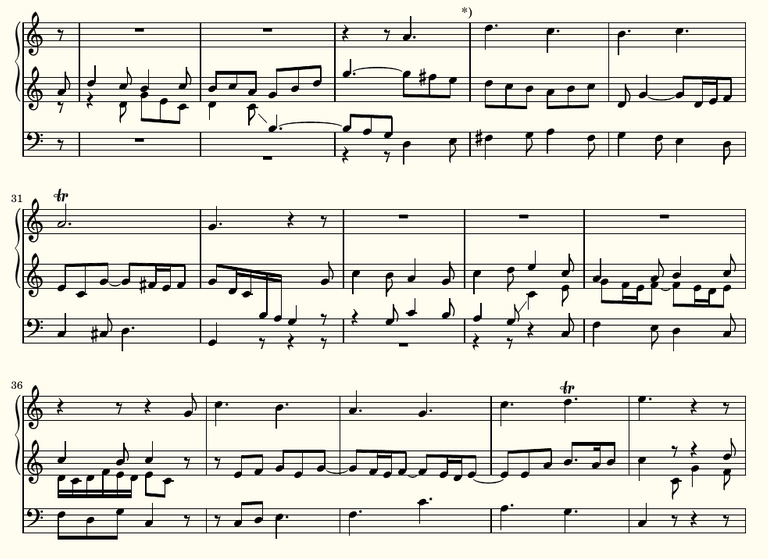I have a website, called Partitura Organum, where I publish new scores of (mostly) lesser known compositions for organ. These scores are newly typeset by me, often from a manuscript source. And in the years I've run this website I've read through quite a lot of manuscripts. And while reading those mnuascripts, two things bug me: compositions of which the composer is unknown and compositions which are incomplete.
Compositions that are anonymous are often forgotten. Somehow the human psyche wants to attach a name to go with the composition, to admire the composer and to know (or to be able to look up) who he or she was, ewhen he lived, etcetera. And you can't do that with some anonymous composer.
And invariably, if the composer is unknown, if musical scholars have not succeeded in there research (if they even did that) to determine who was the composer, there's little chance I can pinpoint the composer. But I can typeset the score, publish it on my site and thus make it more likely that someone somewhere will play the music. It wont be played from a dusty manuscript that lies somewhere in some library.
In a way, what I do is archealogy. I unearth forgotten compositions and by typesetting them make them playable again.
The other thing that I always regret is an incomplete composition. And most of the time it is not incomplete because the composer did not finish it, but because there is a page missing from the manuscript. And that happens rather often. In almost every manuscript that contains complete compositions, one or two pages are missing and there's is only a fragment left of one (or more) composition.
Sometimes that fragment is only a few bars long. Sometimes the fragment is quite substantial and long enough to see it's a good composition, that is sadly unplayable because it is not complete.
A few years ago I transcribed a manuscript containing some 20 plus chorale preludes composed by Georg Andreas Sorge. No less than five of them are incomplete, because there are several pages missing from this manuscript. Of one of these 5 there exist only the four closing bars. Not enough to get an impression of the content and the quality of the compositions. The other four, however, are more substantial, varying from about 1/3 to 2/3 of the complete composition.
Now, how do I know that? How can I know how long a composition was, when there is only a fragment of it in the manuscript? The answer lies in the character of these compositions: they are choral preludes. That means they are based on a choral melody and in this manuscript the preludes all have the same basic layout: one hand and the feet play accompanying material and the other hand plays the complete choral melody, one line at a time. And when all lines are played, the composition is finished, with perhaps a few bars added as a sort of coda.
So if a choral has for example 6 lines and the incomplete score in the manuscript contains 4 of them, I know that two lines are missing, and thus, about 1/3 of the complete composition is missing.
Like most of the compositions in this manuscript, the 4 preludes of which remains enough to get an idea of there musical substance, are actually quite nice pieces. It would be great if there were some way of restoring the missing parts and create a playable version of how the complete composition could have sounded. Sorge was not one the great masters, but he wrote very nice choral preludes, and the fragments that do exist are very nice fragments of music as well.
So, I decided to try to restore one of these composition by somehow composing the missing parts myself. And I wanted the result to be as close as possible to how the complete original could have sounded by staying faithful to Sorge's style and to the way he composed this type of music. Idealy, a listener should not be able to hear where Sorge's composition breaks of and where my writing takes over.
The part that does exist is quite extensive, five complete systems on one page. The title is written on the top of the page: "O Herre Gott, dein Göttlich Wort". The complete melody of this choral looks like this:

I've drawn a box around the notes at the end of the first system, because if you look at the last system in the manuscript you'll see that the manuscript breaks of at precisely that point:

So, we miss a little over half of the composition, because we miss 6 bars of the choral melody. That's quite a lot of material to compose anew.
Well, perhaps not.
If you look closely at the second system of the choral melody, you'll notice that the melody in bars 8-11 is the same as in bars 1-4. So, for these bars at the end of the choral melody, I can simply reuse the material Sorge wrote for the first 4 bars of the choral melody. And I have only to compose new material for bars 6 and 7.
The compositional procedure Sorge uses in this choral prelude is each fragment of the choral melody is introduced with a short introduction in the accompanying parts. And this short introduction is build mainly on the fragment of the choral melody it introduces. So, besides writing an accompaniment for bars 6 and 7 of the choral melody, I have one more thing to do: write a short introduction for the fragment of the choral melody that starts on the last note of bar 7.
And though that fragment is largely the same as the first fragment of the choral melody, I cannot use the material Sorge writes at the start of the composition. In all his other choral preludes (and in this one as well), Sorge writes a rather long first introduction (of 8 or even more bars) that he does not repeat in the rest of the composition. Therefore, I had to write something new to introduce that fragment of the choral melody.
I decided to write a short fugato on that fragment of the choral melody, as Sorge does the same with some of the other fragments of the choral melody. And on top of that I used the material of two bars from Sorge's original introduction. The result looks like this:

To round it of, I wrote a short coda, no more than 4 bars. And that is one incomplete choral prelude restored. Succesfully? Well, the proof of the pudding is in the eating. And the proof of this restoration is in the hearing. Tomorrow I'll upload a recording of this composition.
And then anyone can hear wether or not I succeeded in my goal: it should not be noticeable where Sorge's writing breaks of and where my writing takes over.
